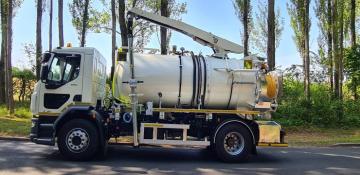
In October 2024, the Direct Vision Standard (DVS) rules aimed at improving road safety, particularly for vulnerable road users such as cyclists and pedestrians are changing. These regulations, enforced primarily in urban areas, require all commercial vehicles to meet certain visibility standards to reduce the risk of accidents.
What are the DVS Rules?
The DVS rules require all goods vehicles over 12 tonnes GVW (gross vehicle weight) to obtain a safety permit to operate within Greater London. The permit is based on the vehicle's direct vision performance, which measures how much the driver can see directly through the cab windows. Vehicles are rated from zero stars (poor visibility) to five stars (excellent visibility). Those rated below one star are prohibited from operating in the city unless they have additional safety equipment installed to mitigate blind spots.
What is changing?
From 28 October 2024, if your HGV is rated zero to two stars you will need to upgrade it to three stars by fitting it with a Progressive Safe System (PPS) or to prove these works are scheduled within the Transport for London (TfL) grace period. This comprises seven requirements including a Camera Monitoring System (CMS), a Blind Spot Information System and other audio and visual alert systems to improve safety.
Grace period allowed by TfL
TfL have announced an extension to the grace period which gives fleets more time to prepare. Initially given 3 months from the end of October to comply, hauliers must now ensure all work is carried out by 4 May 2025.
To qualify for the grace period those impacted need to provide evidence that installation works have been arranged by October 28, or will be found non-compliant.
What should businesses do now?
There are four simple steps you can take now to ensure your commercial vehicles are DVS II ready:
- Assess Fleet Visibility: Evaluate the visibility performance of your existing vehicles using the DVS star rating system. Identify vehicles that may require modifications or upgrades to meet the minimum visibility standards.
- Invest in Safety Equipment: Install additional safety equipment, such as cameras, sensors, and audible warning systems, to improve visibility and reduce blind spots. Consider retrofitting older vehicles to enhance their safety capabilities.
- Driver Training and Awareness: Provide training to drivers on the importance of visibility and blind spot awareness. Emphasize the need for vigilance and proper use of mirrors and other safety features to mitigate risks.
- Monitor Compliance: Regularly monitor and assess fleet compliance with the DVS rules. Implement procedures to ensure that vehicles are properly maintained and equipped to meet safety standards.
To speak to one of our specialists today about upgrades or installations for your Close Brothers Vehicle Hire fleet, call us on 0345 4600601 or email enquiries@cbvh.co.uk.



